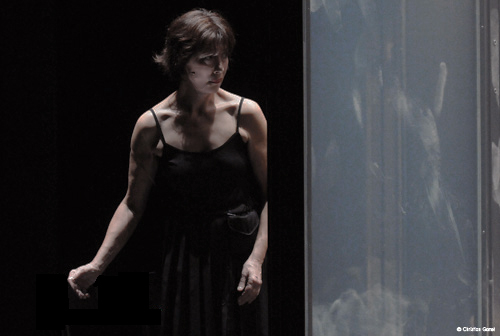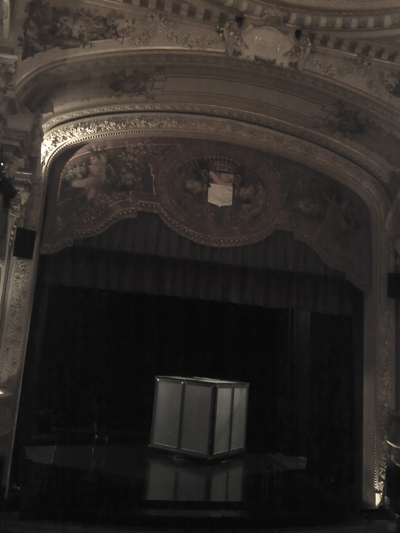 stage setup in an italian style theatre
stage setup in an italian style theatre
10_2010
+++++++++++++++++++++++++++++++++++++++++++++++++++
La Nuit les Brutes is a theatre music piece created on october 6th 2010 at Les Celestins in Lyon, France.
It was a co-production by Les Celestins, théâtre de Lyon & Act-Opus & Espace des Arts Scène Nationale de Châlon sur Saône with the help of Théâtre de l’Ouest Parisien and Saint Gobain.
with
Anne Alvaro – Maria
Chlotilde Monnier – Ethel
Jean Claude Saragosse – Brute & bass singer
Pascal Contet & Stephan Puc – accordion
Olivier Pasquet – live electronic
text from Fabrice Melquiot.
Roland Auzet – director, composition, stage design
Gaelle Thomas – assistant, stage design
Roland Auzet & Gaelle Thomas
Bernard Revel – light
Hervé Poeydomenge – dress design
Nathy Polak – makeup
A house, occupied by two women, Ethel and Maria. Or sisters or friends, two women linked by the impression of a man who, years earlier, administered his violence, as he gives a child his sleep medication. We know very little about the conditions of their detention. How he feed them, beat them etc… But since, they live poisonous, venomous, seeking the brute in every man they meet. During those nights when they use to go and meet men in bars where they get lost. Addicted to a violence they chose to maintain, they decided to make masochist contracts with strangers in order to better dominate them. When they return home, they find him back, him, the only beast, the destroyer, the thief of small girls. It is their turn to lock him up. They feed him, administer their violence. Because he must pay, because they must pay with him, this violence goes up to the pleasure and is wanted until the death is reached, glorified as much as cursed.
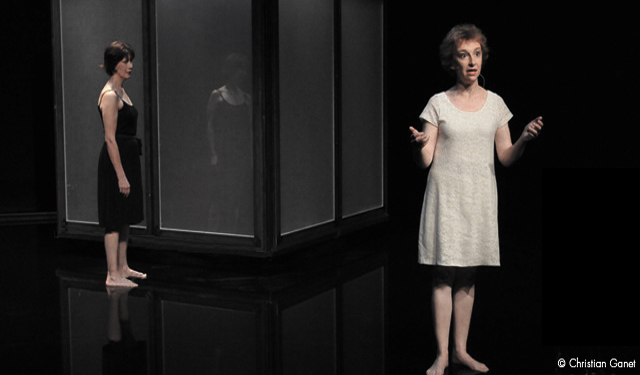 anne alvaro & clotilde mollet feet in water
anne alvaro & clotilde mollet feet in water
The concept of the stage is rather simple. It consists on a square of thin water in which both women walk. Two chairs and a large cube made of metal and glass reflect in this water floor. The bass singer is inside the box and never escapes from it. The two other musicians are outside the square. The accordionist is on the left side and the electronic musician in the hall with the sound engineer.
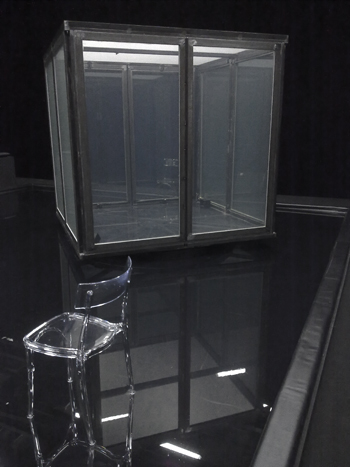 box of the beast with glass in transparent position box of the beast with glass in transparent position |
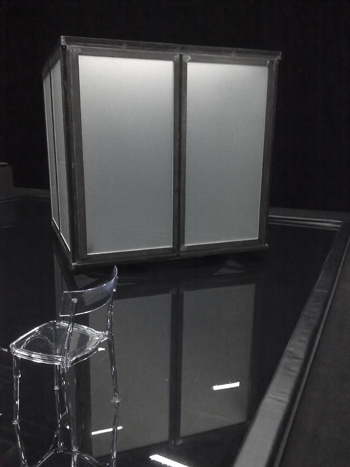 box of the beast with glass in opaque position box of the beast with glass in opaque position |
The box is a cage for the beast. This prison can change its opacity thanks to a special glasses. This system, which is called privalight, has been given by the Saint Gobain glass company. A polarized lcd layer changes the opacity with electricity. This way, it is possible to synchronize the opaqueness for each glass of the box with music. I made simple permutation effects in relation with the music, the live effects of voices and the dramaturgic needs.
Theatre music is interesting because the music part is in close relation with stage, dramaturgy and sometimes text. Many problems tend to occur with usual French institutional theatre. Indeed unlike video and lighting, music uses the same medium as the voice so the blindly well protected spoken text. Many theatre directors have a deep lack of culture and interest for music. They have no clue and no abstract concept about how to integrate it in a show. For them it is often just a figurative effect. This problem is less perceivable outside of France. German spoken countries for instance have a real culture for stage, for theatre music, for theatre and for music. This is quite similar from what I have seen in Korea at Intermedia Performance Lab. This is why La Nuit les Brutes is a little difficult to classify in France. Working for a theatre music piece reminded me the years when I was working at the Forum fur Neues Musiktheater at the Stuttgart Staatsoper or when I work for dance shows.
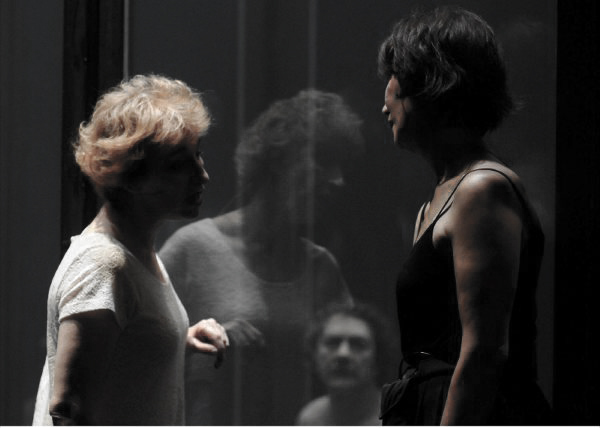 anne alvaro, clotilde mollet & jean-claude saragosse
anne alvaro, clotilde mollet & jean-claude saragosse
For musicians, it is an interesting challenge to respect both the logic for music and for the dramaturgy. For instance events or apparitions are sometimes physical and tightly synchronized with actors gestures (~100ms). This is the reason why I automatized many things like the glasses etc…
The tessiture and dexterity of the accordionist allow for writing music that is sometimes similar to a piano with possible additional long notes. Most of the time, a very thin filter is applied to the bass voice, in the cage. This trio between the bass, the accordionist, and the live electronics allows a wide range of possibilities in terms of meaning thanks to the voice, in terms of tessitures with the accordion, and in terms of dynamics with the electronics. This instrumentarium oscillates between beautifully written tonal “”quotations”” of Robert Schumann and Frédéric Chopin and short timbral improvisations. When needed, some written atonal music stands in the middle of all that. The music of this show has to be perceived as a rich range that fits the best with the rest of the show. This is the clever thing about it.
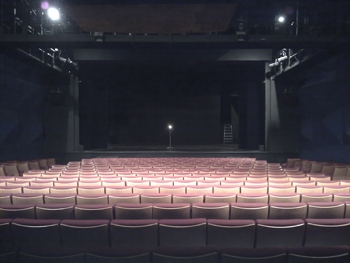 the box is not setup on stage yet
the box is not setup on stage yet
The electronics consists of live processes on the actress’s voice, the bass, and the accordion. There are also many fixed sounds. Once again, here, the esthetics oscillates between stylish acousmatic articulations and a more minimal electronic music type. For instance, the direct sound is entirely cut when the Brute dies and Maria and Ethel get inside the cage. Remain fast-moving transformed and delocalized voices in the hall. We understand what they say. Crackling sounds rhythmically evaluate underneath with an additional very loud 80 Hz continuous sine bass. This bass comes from a previous pitched unison with the accordion. Suddenly the brute bestirs itself and a huge, impressive, movement pops up with some synched blinking of the glasses. Then everything instantly stops and this is the end.
